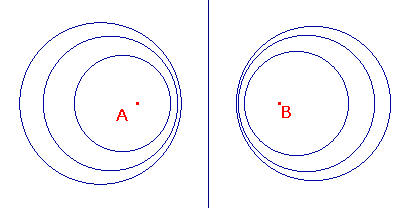- Ak(A,B) is a line if k is 1, and a circle if k is not 1.
- A and B are inverse with respect to Ak(A,B).
- If A and B are inverse with respect to an i-line L,
then L = Ak(A,B) for some k.

We choose the perpendicular bisector of AB as the y-axis,
and the line AB as the x-axis, so if A is (a,0), then B is (-a,0).
Then P(x,y) lies on Ak(A,B) if and only if
PA = k.PB.
Squaring, we get
(x-a)2 + y2 = k2{(x+a)2 + y2 }.
Rearranging, we have (k2-1)(x2 + y2 + a2) + 2a(k2 +1)x = 0.
If k = 1, this gives the line x = 0 (the perpendicular bisector of AB).
Otherwise, we can divide by (k2 -1) to get the circle
To prove the other two parts, we begin by considering when A and B
are inverse with respect to a circle C, centre F, radius r.
Since B is inverse to A, B must lie on FA, so F is on AB, the x-axis.
Thus,F is of the form (f,0).
Note that, A and B must lie on the same side of F, so |f| > |a|.
Finaly, we require that FA.FB=r2, i.e.
|f-a||f+a| = r2.
As |f| > |a|, this becomes f2 - a2 = r2.
Thus, A and B are inverse with respect to C if and only if C has equation
Part two follows at once, since Ak(A,B) has this form (k not 1).
Obviously, the only line with A and B inverse is the perpendicular bisector.
For the third part, we need to show that any circle x2 + y2 -2fx + a2 =0
belongs to A(A,B).
Given the form of the general member of A(A,B) established in part one,
we need only check that we can choose k with a(k2+1)/(k2-1)=-f.
A little manipulation shows that this requires
k2=(f+a)/(f-a) = (f+a)2/(f2-a2).
Since we must have f2 > a2 for C a real locus, we see that
The value for k2 is positive, so k exists.